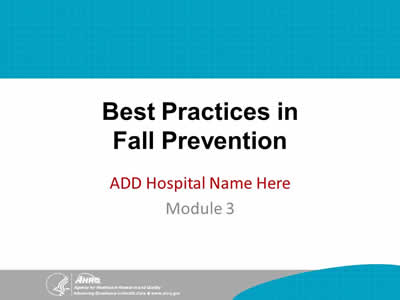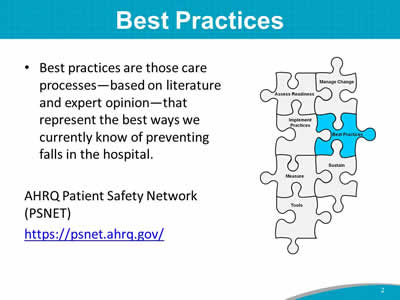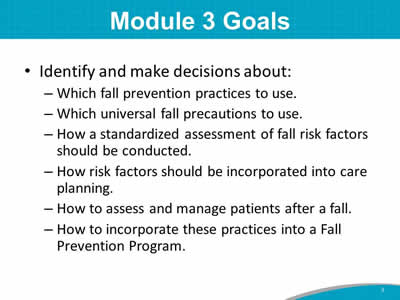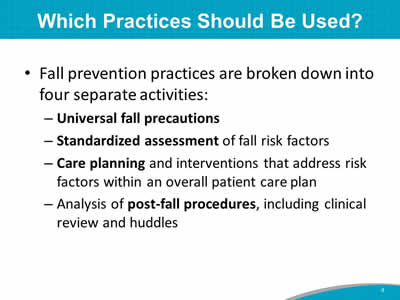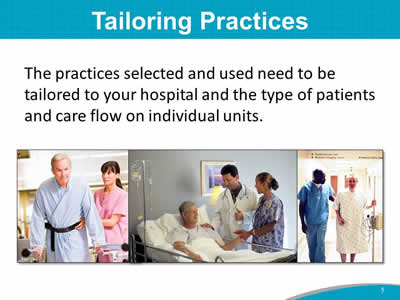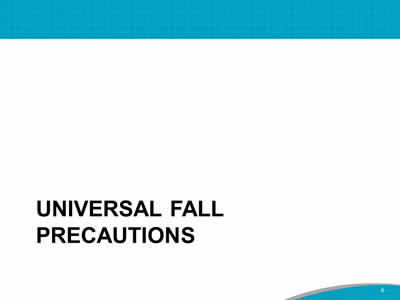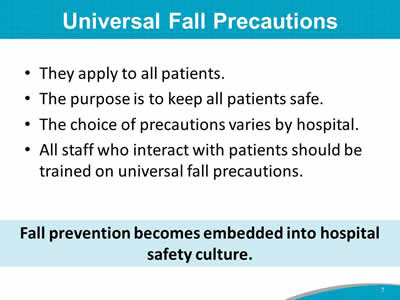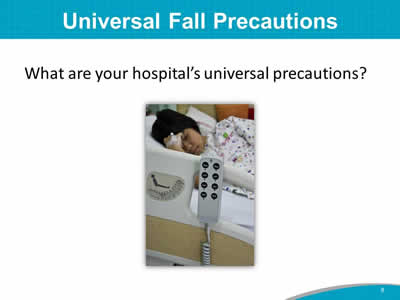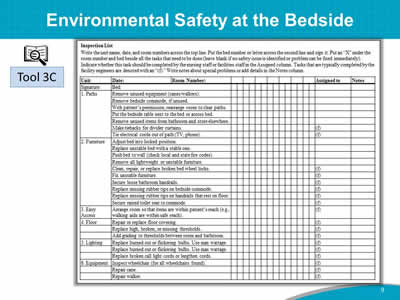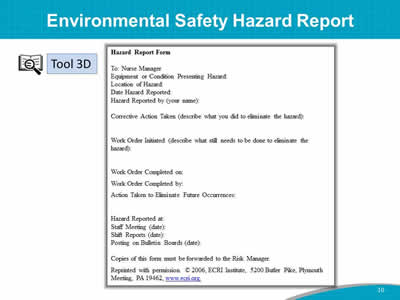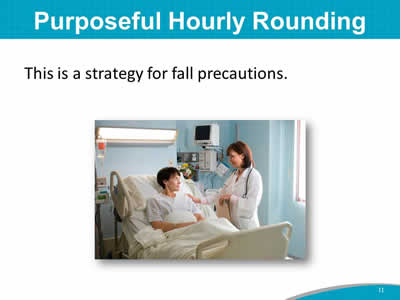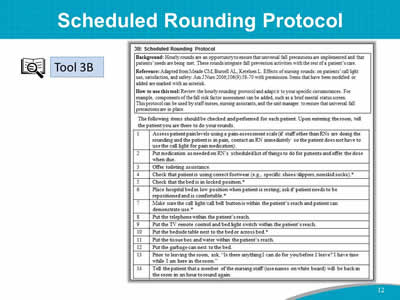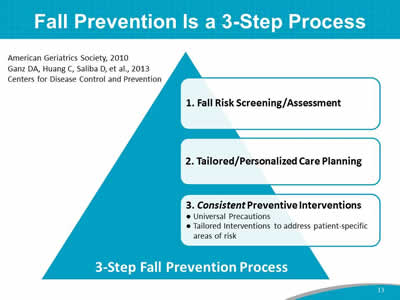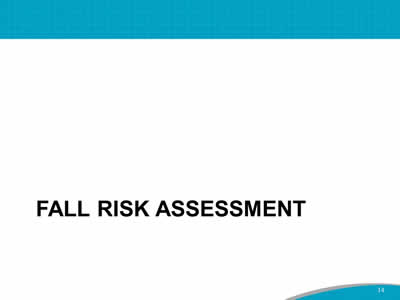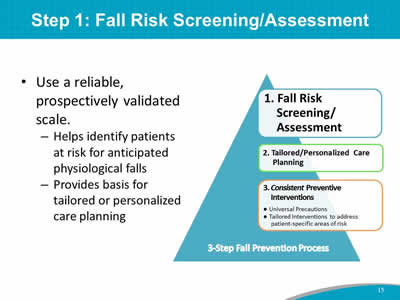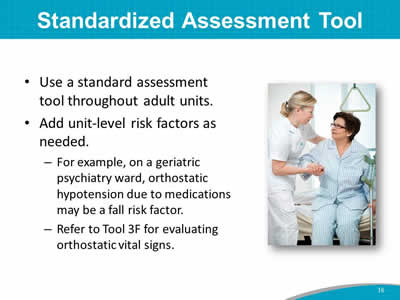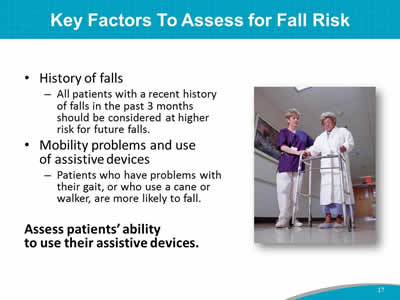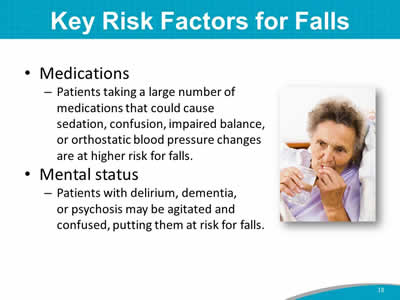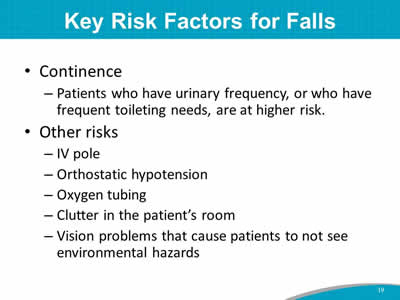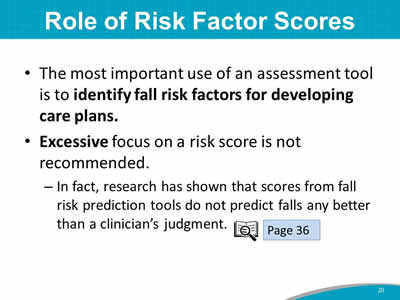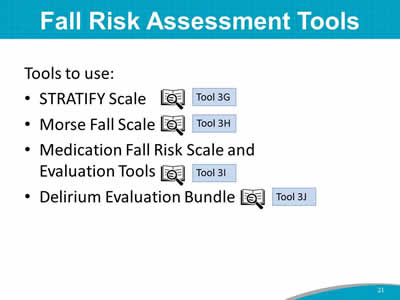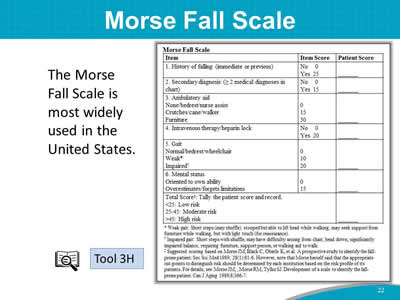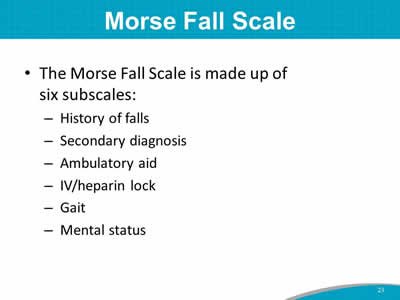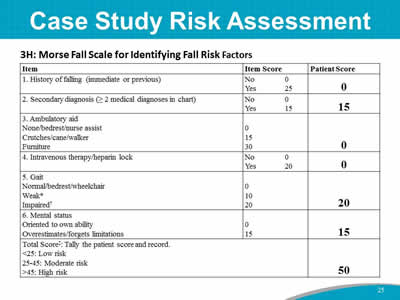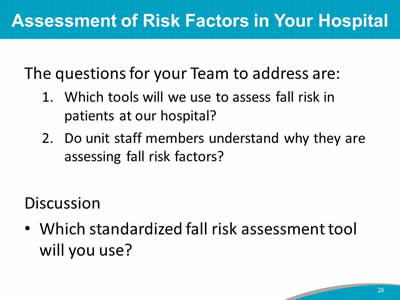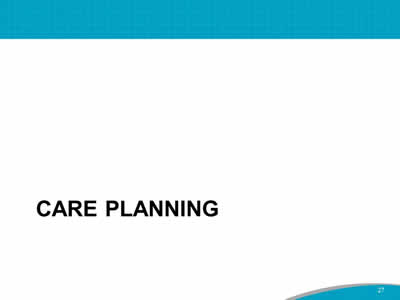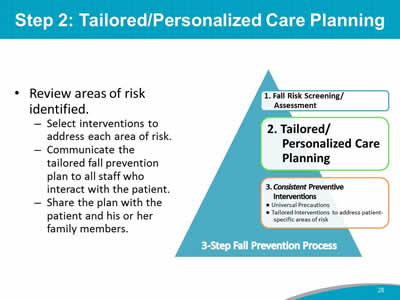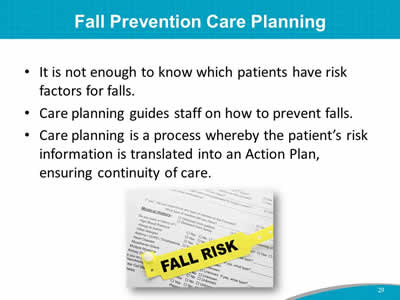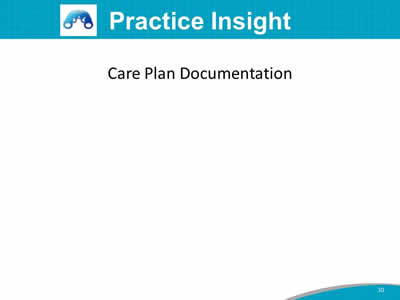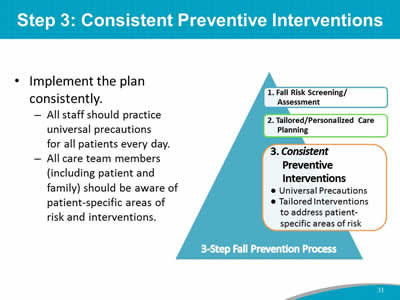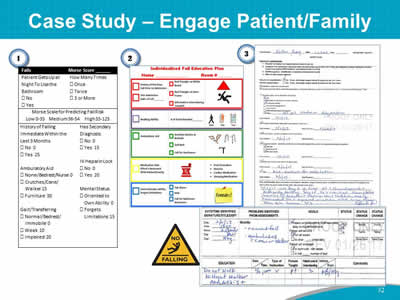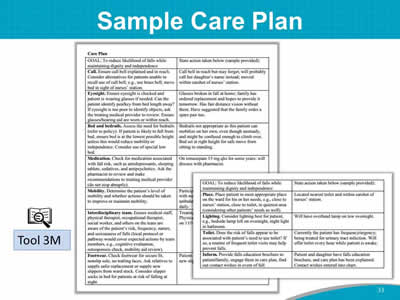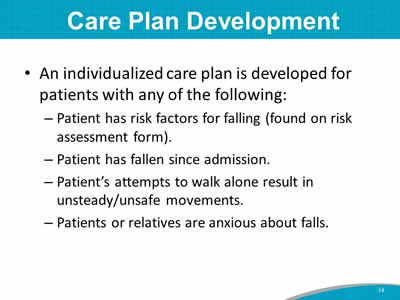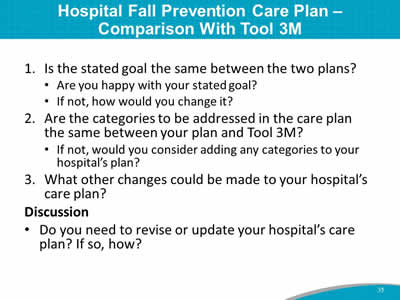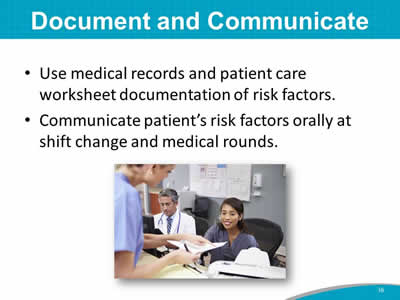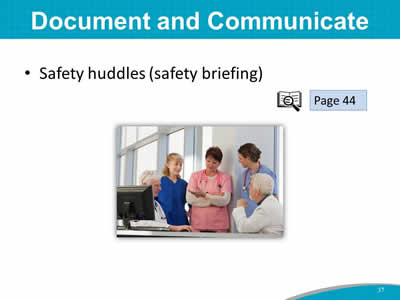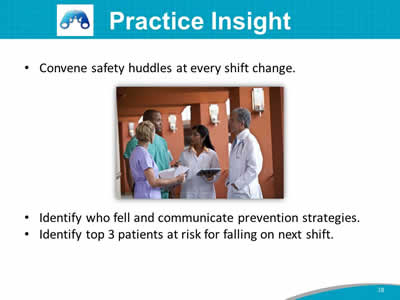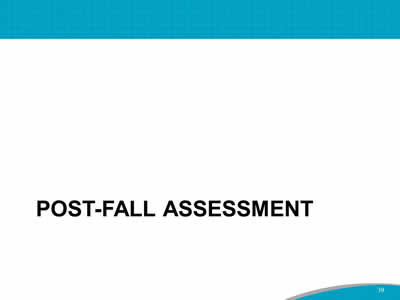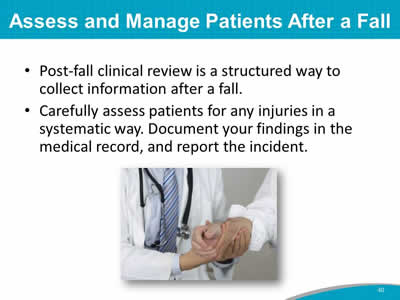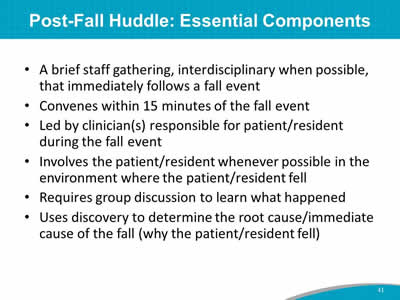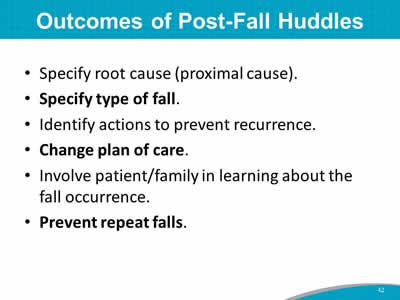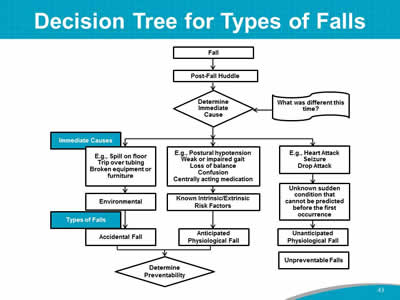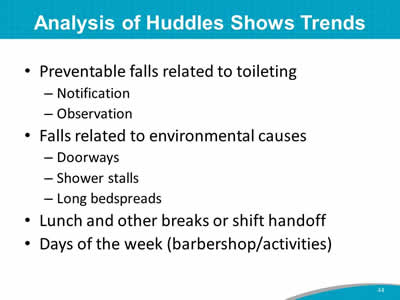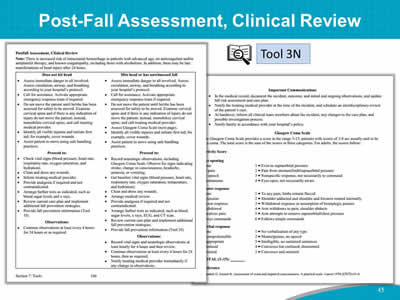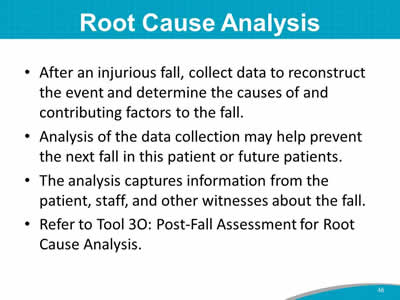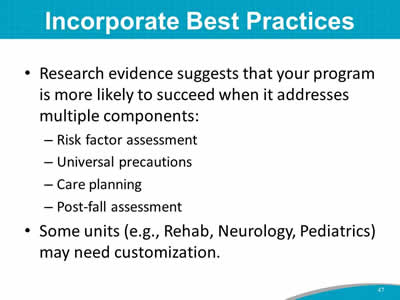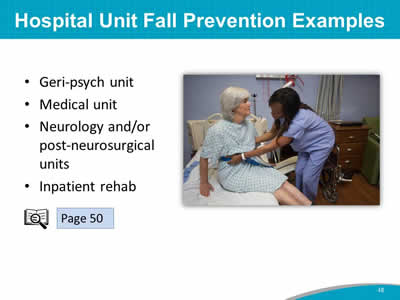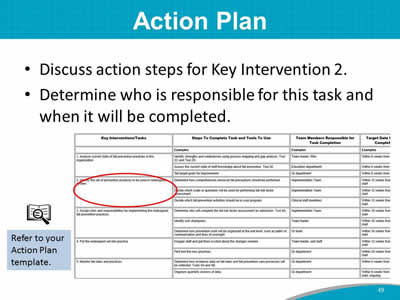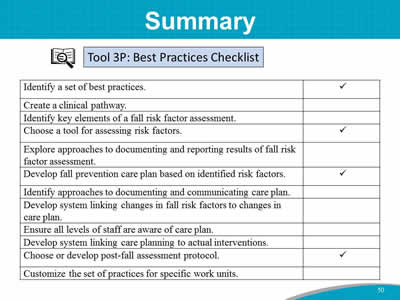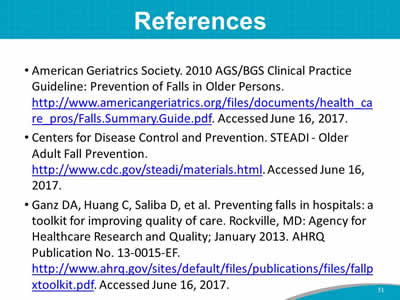Module 3: Best Practices in Fall Prevention—Training Guide
Module Aim
The aim of this module is to support your efforts to use best practices as outlined in the Preventing Falls in Hospitals Toolkit in your hospital’s Fall Prevention Program.
Module Goals
The goals of Module 3 are to have the Implementation Team identify opportunities for prevention improvement related to fall prevention practices:
- Which fall prevention practices to use.
- Which universal fall precautions to use.
- How a standardized assessment of fall risk factors should be conducted.
- How risk factors should be used for individualized care planning.
- How to assess and manage patients after a fall.
- How to incorporate these practices into a Fall Prevention Program.
Timing
This module will take 80 minutes to present. Below is the estimated time needed to present each topic:
| Slide numbers | Topic | Time in minutes |
|---|---|---|
| 1–5 | Introduction | 5 |
| 6–13 | Universal Fall Precautions | 15 |
| 14–26 | Fall Risk Assessment | 15 |
| 27–38 | Care Planning | 20 |
| 39–48 | Post-Fall Assessment | 10 |
| 49–50 | Action Plan and Summary | 15 |
Learning Methodology Checklist
- Large group discussion.
- PowerPoint slide presentation.
- Case study.
Additional Related Training Resources
- Using Fall Risk Assessment Tools in Care Planning—AHRQ Fall Prevention Program Training Webinar.
- Post-Fall Huddles: Reducing Preventable Falls and Fall-Related Injuries—AHRQ Fall Prevention Program Implementation Sharing Webinar.
- Patient-Centered Fall Prevention Care Planning—AHRQ Fall Prevention Program Implementation Sharing Webinar.
- Evidence for Fall Prevention Strategies—AHRQ Fall Prevention Program Implementation Sharing Webinar.
Materials Checklist
- LCD projector and laptop.
- “Parking Lot” flip chart page and markers.
- Flip chart page with “Best Practices” written at the top, along with the following two columns:
Best Practices Decisions
| Practice | Decision |
|---|---|
| Universal precautions | |
| Risk factor assessment | Which assessment tool? |
| Purposeful rounding | When and how often? |
| Care planning | Develop or modify existing? |
| Post-fall huddle | When do you do it? |
| Root cause analysis | When do you do it? |
| Some units may need customization (e.g., rehab or neurology units, pediatrics) |
Instructor Preparation
- Add the specific hospital name to the first slide.
- Have the PowerPoint file Module 3 cued on the computer and minimized.
- Participants should have Tool 2F: Action Plan available, as they will continually add to it in each module.
- Ask the Team Leader which fall risk assessment tool the hospital uses.
- Alert the Implementation Team Leader(s) or designee(s) to be ready to talk about the following current hospital policies and practices:
| Hospital Practice | Copies Available? Y/N |
Who Will Discuss? |
|---|---|---|
| Universal fall precautions | ||
| Standardized fall risk assessment | ||
| Adult unit fall prevention care plan | ||
| Post-fall huddle | ||
| Root cause analysis |
- Have a copy of the following materials for all participants:
- Module 3 PowerPoint slide presentation handout, 3 slides to a page.
- The hospital’s universal fall precautions, if available.
- The hospital’s adult unit fall prevention care plan, if available.
- Tool 3A: Inpatient Falls Clinical Pathway.
- Tool 3B: Scheduled Rounding Protocol.
- Tool 3C: Environmental Safety at the Bedside.
- Tool 3D: Hazard Report Form.
- Tool 3G: STRATIFY Fall Risk Scale.
- Tool 3H: Morse Fall Scale (to use for the case study activity).
- Tool 3I: Medication Fall Risk Score and Evaluation Tools.
- Tool 3J: Delirium Evaluation Bundle.
- Tool 3M: Sample Care Plan.
- Tool 3N: Post-Fall Assessment, Clinical Review.
- Tool 3O: Post-Fall Assessment for Root Cause Analysis.
- Customized Tool 3P: Best Practices Checklist.
Module 3: Best Practices in Fall Prevention
| Slide | Script |
|---|---|
|
Slide 1
|
Say: Module 3 introduces best practices and how to determine which fall prevention practices you want to use in your hospital. |
|
Slide 2
|
Say: For this training, best practices are defined as those care processes that, based on literature and expert opinion, represent the best way we currently know of to prevent falls in the hospital. Examples of best practices are universal fall precautions, fall risk assessments, patient care plans tailored to identified individual risk factors, and use of purposeful rounding. The AHRQ Patient Safety Network (PSNet) is a resource for staying current on tested strategies or best practices for prevention and resources. Find current information at https://psnet.ahrq.gov/. |
|
Slide 3
|
Say: The goals of Module 3 are to have the Implementation Team identify opportunities for prevention improvement related to fall prevention practices. These include:
At various points in our discussion, you will be asked which best practices you think you want to include in your prevention program. |
|
Slide 4
|
Say: An important question to answer is: Which fall prevention and post-fall practices should be used? To simplify, fall prevention practices are broken down into four separate activities:
Say: Let’s take a few minutes to reflect. Ask: Of this bundle of best practices listed on the slide, which ones are you already using? |
|
Slide 5
|
Say: The practices selected and used need to be tailored to your hospital and the type of patients and care flow on individual units. |
|
Slide 6
|
Say: Let’s start by talking more about best practices for a Fall Prevention Program. Please continue to jot notes about opportunities for improvement that can later be considered for your organization’s Action Plan. The first is universal fall precautions. They are the cornerstone of any hospital’s Fall Prevention Program, because they apply to all patients at all times. |
|
Slide 7
|
Say: Universal fall precautions are the basics of patient safety.
By implementing universal fall precautions, the hospital embeds the importance of fall prevention into its safety culture. |
|
Slide 8
|
Do: Hand out the hospital’s universal precautions (if available). Instructor’s Note: If the hospital has fall prevention as part of its universal precautions, ask the Implementation Team Leader to review the universal precautions. Say: Let’s look at the fall prevention strategies in your hospital’s universal precautions list. Ask: What fall prevention strategies are listed in your hospital’s procedures? Is any precaution missing from your list? |
|
Slide 9
|
Say: Let’s look at examples of other tools to be used to help keep patients safe from falls. Use Tool 3C as an inspection checklist. The checklist will show all the things you are doing well. For example, securing tiebacks on curtains, securing raised toilet seats to commodes, and making sure lights work. The inspection may also reveal some situations where falls can occur. For example, broken beds, nonworking lights. |
|
Slide 10
|
Say: Tool 3D is a sample hazard report form for reporting any detected environmental hazards. Examples of hazards include items left in the hallway and wet floors that are not mopped properly. Ask: What are some other hazards you can think of? Say: Ask the unit manager and facility engineer to identify and resolve safety and environmental issues in hospital rooms and hallways. |
|
Slide 11
|
Say: Purposeful rounding is a strategy for fall precautions, especially for those patients who have been identified as needing frequent toileting for bladder retraining or toileting before pain medication is given, or who just need assistance to the toilet. Purposeful rounding is a proactive and systematic approach that helps anticipate and address patient needs. If you already have purposeful rounding on some units for other patients’ needs, fall prevention strategies could be included. Scheduled rounding will need to be evaluated by the Team. |
|
Slide 12
|
Say: Tool 3B is a rounding protocol that integrates fall prevention activities with the rest of a patient’s care. This tool could be adapted to your specific circumstances. Ask: Is purposeful rounding a best practice that you want to include in your bundle of best practices? Say: If so, let’s write it on the “Best Practices” flip chart page. If you would like to explore the possibility of including purposeful rounding, let’s write that you would like to discuss it further as a Team. |
|
Slide 13
|
Say: Fall prevention can be viewed as a 3-step process based on a review of the evidence-based literature. Step 1 is fall risk screening and assessment. This serves as the basis for care planning. Using a reliable and validated scale helps care providers identify patients who are at risk for anticipated physiological falls. These are the most common type of falls in hospitals, accounting for approximately 78 percent of all inpatient falls. Importantly, these falls have recognizable risk factors that can be identified using validated risk assessment tools. Step 2 is tailored or personalized care planning. Once the assessment is complete, interventions are selected and the plan is tailored to the patient. This plan is communicated to all staff who interact with the patient, as well as to the patient and the family. Step 3 is consistent preventive interventions. To accomplish this goal, all staff need to practice universal precautions for all patients, everyday. All Team members need to be aware of patient-specific areas of risk and which interventions will prevent the patient from falling. |
|
Slide 14
|
Say: Let’s talk about Step 1: standardized assessment of risk factors for falls. Assessment of risk factors for falls is a standardized and ongoing process with the goal of identifying individual patient risk factors. This assessment is usually done upon admission and routinely thereafter. The most important reason for using an assessment tool is to identify fall risk factors that can support developing an individualized care plan for each patient. Reassessment should be done whenever there is a change in a patient’s condition, or when he or she is being transferred to another unit. Do: Ask the Implementation Team Leader to address the following questions:
Which risk assessment tool do you use? |
|
Slide 15
|
Say: It is recommended that you use a reliable, prospectively validated risk assessment scale. This helps to identify patients at risk for anticipated physiological falls and provides the basis for a tailored or personalized care plan. |
|
Slide 16
|
Say: A standardized assessment tool should be used throughout adult units. Add unit-level risk factors as needed. For example, on a geriatric psychiatry ward, a fall risk factor may be orthostatic hypotension due to medications. Refer to Tool 3F for evaluating orthostatic vital signs. |
|
Slide 17
|
Say: Key risk factors to be assessed are:
|
|
Slide 18
|
Say: Other key risk factors include:
|
|
Slide 19
|
Say:
Here are some other risks:
|
|
Slide 20
|
Say: The most important use of an assessment tool is to identify fall risk factors for developing care plans. Excessive focus on a total risk score is not recommended. In fact, research has shown that risk scores derived from tools do not predict falls any better than a clinician’s judgment. (This is discussed on page 36 of the Toolkit.) |
|
Slide 21
|
Say: A variety of tools can be used to assess fall risk. Two tools have been studied the most: the Morse Fall Scale and the STRATIFY tool. Both scales have established reliability and validity. The key message here is to include a scale that has been tested and found to be reliable and valid. It is important that you consistently use one tool over time. Another scale that has established reliability and validity is the Hendrich II scale. It is also recommended that medications be reviewed as part of a fall risk assessment (Tool 3I). A pharmacist should be involved in the assessment of those taking high-risk meds. Also included in the Toolkit is an altered mental status tool (Tool 3J: Delirium Evaluation Bundle) that can be used with cognitively impaired patients. This hospital is currently using (name of risk assessment tool being used). Today we’ll take a closer look at the Morse Fall Scale. |
|
Slide 22
|
Say: Tool 3H is the Morse Fall Scale. This is the most widely used scale in U.S. hospitals, and it has the most research to validate it. |
|
Slide 23
|
Say: It is made up of six subscales:
Other scales may be used instead of the Morse Scale. The key point is to ensure that standard scales are used throughout adult units, with additional risk factors assessed, as needed, for specific units or as suggested by clinical judgment. |
|
Slide 24
|
Say: Use of the Morse Fall Scale is not time consuming. I’d like you to take out Tool 3H. Pair up and use the scale to assess a patient in the following case study for risk of falling. The patient is a 45-year-old male with type 2 diabetes who is post-hip replacement. He has no recent history of falling. Because of hip pain, he has difficulty walking. He has no ambulatory aid or IV or heparin lock. He is currently on pain medication, which makes him dizzy, and he underestimates his limitations. Do: Give participants 5 minutes or so to assess this patient. Have 2 or 3 pairs of participants say what risk assessment score they would give this patient upon admission. |
|
Slide 25
|
Say: A risk score of 50 puts this patient at risk for a fall. Ask: How long did it take to come up with a risk assessment score? What elements in this case study may change quickly and reduce his risk for a fall? Answer: A decrease in his pain would decrease the need for pain meds. |
|
Slide 26
|
Say: One question to be addressed today is: Which assessment tools will you use to assess fall risk in patients at your hospital? Ask: Can we decide at this point, at least preliminarily, which fall risk assessment tool you want to use or explore using? Do: Write the fall risk assessment tool the Team members want to use, or explore the use of, on the “Best Practices” flip chart page. Say: Another question to be addressed today is: Do unit staff members understand why they are assessing fall risk factors? This is a training issue. |
|
Slide 27
|
Say: The next step in being effective at preventing falls is to address risk factors in the patient’s care plan. |
|
Slide 28
|
Say: Let’s talk about Step 2: tailored or personalized care planning. Once the assessment is complete, interventions are selected and the plan is tailored to the patient. This plan is communicated to all staff who interact with the patient, as well as to the patient and the family. |
|
Slide 29
|
Say: It is not enough to know which patients have risk factors for falls; you must also address them. Once risk assessment has helped identify patient risk factors, care planning should match the identified risks, such as mobility challenges, medications, mental status, and continence needs. Care planning guides staff on how to prevent falls. Fall prevention care planning is a process by which the patient’s risk assessment information is translated into an Action Plan to address the patient’s needs. It is an active document that ensures continuity of care and changes as the patient’s condition changes. The use of individualized care plans supplements the use of universal fall precautions. |
|
Slide 30
|
Say: An acute-care hospital changed its EMR documentation from a checkbox system to a free-text system. While more time consuming, it improved nurses’ use of critical thinking when assessing fall risk and individualizing care plans. Clinical directors on the units now perform twice-daily chart audits and provide staff education in real time as issues are found. This approach improved accountability and sustainability. |
|
Slide 31
|
Say: Finally, let’s talk about Step 3: consistent preventive interventions. To accomplish this goal, all staff need to practice universal precautions for all patients, everyday. All Team members, including the patient and family caregivers, need to be aware of patient-specific areas of risk and which interventions will prevent the patient from falling. |
|
Slide 32
|
Say: This case study describes the way one hospital has approached involving patients in their plan of care. A Fall Prevention Team from a large metropolitan hospital began a program of engaging patients and families in the 3-step fall prevention process. Step 1: As shown on the left, under item 1, at the beginning of each shift, a nurse performs an assessment of the patient. The nurse identifies potential fall risk and behaviors that increase the risk of a patient fall.
Step 2: The education plan is then placed on a white board or at the patient bedside as a visual tool so that staff and family members who enter the patient’s room know the patient’s risk factors and the interventions that should be in place. Step 3: The education plan is documented and revised as patient status changes. |
|
Slide 33
|
Do: Ask participants to take out Tool 3M: Sample Care Plan. Say: Tool 3M is a Sample Care Plan that includes examples of interventions that may be considered for specific fall risk factors. These interventions should be tailored to meet your patient’s needs. |
|
Slide 34
|
Say: The fall risk factors addressed on the Sample Care Plan are:
Additional factors may be added. Let’s take a few minutes to review your hospital’s care plan for fall prevention. |
|
Slide 35
|
Say: Pass out the hospital fall prevention care plan, if available. Ask the Implementation Team Leader or designee to review it with participants and cover the following points: Compare your hospital’s adult unit fall prevention care plan with the Sample Care Plan.
Do: Write “Revise care plan for fall prevention” or “No need to revise current care plan” on the “Best Practices” flip chart page. |
|
Slide 36
|
Say: It’s critical to document fall risk factors and interventions to address those risk factors in the care plan. This approach ensures continuity of care and staff knowledge of what should be done for the patient. Some hospitals choose to have a dedicated care plan form within the medical record to help make staff aware of a patient’s risks. Medical record documentation is necessary, but not sufficient. You also need to communicate patients’ risk factors orally at shift change, and by review of the medical record or patient care worksheet. |
|
Slide 37
|
Say: Patients who are at particularly high risk for falls can be discussed as part of the unit’s safety briefing or huddle. (This is addressed on page 44 of the Toolkit.) |
|
Slide 38
|
Say: This practice insight describes how one hospital modified its safety huddles when implementing AHRQ’s Preventing Falls in Hospitals Toolkit. Fall Prevention Team leaders and staff in an acute-care hospital identified an opportunity to heighten collective and individual awareness of patients on the unit who were at the highest risk of falling. This hospital observed that many of its patients were considered high risk based on Hendrich Risk Assessment results. However, they determined that they needed to identify and focus on those most at risk. The shift huddle process was examined, and it was determined that this huddle could be used to enhance communication about fall risk. The huddle was revised to include information on patients who had fallen, plus the top three patients most at risk to fall on the next shift. Leaders monitored this process across shifts to assess compliance, benefits, and challenges. Nursing staff and charge nurses appreciate the predictability of the message and know what to expect. When notified of the top three patients at highest risk to fall, they have a heightened sense of awareness. If they see a call light or hear an alarm for those patients, they know that it may be an opportunity to prevent the patient from falling. |
|
Slide 39
|
Say: Despite your best efforts, patients will fall, and some may even sustain an injury. Ask: Do you have a post-fall clinical review process or post-fall huddle protocol at your hospital? Do: If the hospital has a post-fall clinical review protocol, ask the Team Leader or designee to describe it. |
|
Slide 40
|
Say: A post-fall clinical review is a structured way to collect information after a fall. The patient should be carefully and systematically assessed for injuries. All findings should be documented in the medical record, and an incident report should be filled out. The post-fall clinical review focuses on immediate risk of injury or complications. A post-fall huddle should begin as soon as possible after the fall. |
|
Slide 41
|
Say: The ideal way to do a post-fall huddle is within 15 minutes of the fall, as soon as possible, when it’s fresh in everyone’s minds. The huddle is usually led by the clinician responsible for the patient. It’s important to have more than one person, because one staff member might see something different than another colleague. Different staff members have a different focus. A physical therapist is going to see something differently than a nurse would see. Different disciplines will bring a different eye to the event. It’s also important to have patients involved, asking them what was different and why they fell. This discovery period helps to determine the cause of the fall. |
|
Slide 42
|
Say: The desired outcome of the huddle is to determine the cause of the fall and to specify the type of fall. This process is about looking to see what can be done to prevent future falls of a similar nature, and a huddle is one of the key interventions to reduce repeat falls. Once the cause of the fall has been determined, the care plan for the patient must be changed to incorporate an intervention to prevent a repeat fall. The patient and family should be involved in the post-fall huddle and in the strategies to prevent a repeat fall. |
|
Slide 43
|
Say: This slide displays a decision tree. The cause of falls is important to figure out in the post-fall huddle. Most falls are preventable, but some are not. It is important to separate falls by type and to remember that not all falls are preventable. For example, an unanticipated physiological fall is not preventable. Fall prevention best practices and post-fall huddles should be used to identify and determine how to prevent accidental and anticipated physiological falls. |
|
Slide 44
|
Say: An analysis of post-fall huddle forms may show trends in preventable falls. This slide shows some examples of fall trends from a hospital. Many falls were related to toileting. Patients were getting up to go to the toilet, and some were falling. This finding resulted in staff asking patients to notify them via the call bell that they needed help to get to the bathroom. Other falls were related to environmental causes, such as tripping over bedspreads or tripping over a doorjamb. Several falls happened when fewer staff were on the floor. Fall trends can be included in the implementation plan and used to update or revise an ongoing Fall Prevention Program. |
|
Slide 45
|
Say: This is an example of a Post-Fall Assessment. This tool categorizes patient falls into those falls in which patients do not hit their head or hit their head or have an unwitnessed fall. Ask: Will you include a post-fall clinical review or post-fall huddle as part of your best practice bundle? Do: Add to the “Best Practices” flip chart page if the Team agrees they want to include it. |
|
Slide 46
|
Say: Root cause analysis, or RCA, is used to evaluate and understand types of problems that contributed to undesired outcomes. RCA is often used for a fall with injury. After an injurious fall, you will collect data to reconstruct the event and determine the causes of and contributing factors to the fall. Data collection may help prevent the next fall in this patient or future patients. The analysis captures information from the patient, staff, and other witnesses about the fall. Refer to Tool 3O: Post-Fall Assessment for Root Cause Analysis. |
|
Slide 47
|
Say: We have explored a variety of best practices for fall prevention. Research evidence suggests that your program is more likely to succeed when it addresses multiple components:
Some units (such as rehab, neurology, or pediatrics) may need customization. |
|
Slide 48
|
Say: On some patient units, Fall Prevention Programs are customized for specific patient populations. Here are some examples of fall prevention activities tailored to the unique needs of a patient population:
(You’ll find more prevention examples on page 50 of the Toolkit.) |
|
Slide 49
|
Do: Start a discussion of opportunities for change and action steps for Key Intervention 2: Identify the set of prevention practices to be used in redesigned system. Say: We discussed best practices to include in your Fall Prevention Program. Your ideas are written on the flip chart. Think about who is responsible for this task. Ask: What is a draft target date for completion of this task? Do: Write the Team member responsible and the target date for completion on the form. Say: Keep Tool 2F available in your packet of information, as we will fill out Key Interventions 3 to 5 in the upcoming modules. |
|
Slide 50
|
Say: In this module, we explored the following best practices:
You discussed which practices to include in your bundle of best practices. Let’s take a well-deserved break for lunch. We will start again in just a bit. Do: Give the attached customized Tool 3P to the Implementation Team Leader. Ask him/her to track progress on developing and implementing best practices in fall prevention, specifying who is responsible for each task, where in the process they are, and projected date of completion. |
|
Slide 51
|
Say: For those interested, here is the complete list of references cited in this Module. |
Customized Tool 3P: Best Practices
Purpose: to be used to monitor progress on identifying best practices in fall prevention
| Practice | Who is responsible? | Where are we now? | Completion date |
|---|---|---|---|
| Identify a set of best practices. | |||
| Create a clinical pathway. | |||
| Identify key elements of a fall risk factor assessment. | |||
| Choose a tool for assessing risk factors. | |||
| Explore approaches to documenting and reporting the results of the fall risk factor assessment. | |||
| Develop a fall prevention care plan based on identified risk factors. | |||
| Identify approaches to documenting and communicating the care plan. | |||
| Develop a system linking changes in fall risk factors to changes in the care plan. | |||
| Ensure all levels of staff are aware of the care plan. | |||
| Develop a system linking care planning to actual interventions. | |||
| Choose or develop a post-fall assessment protocol. | |||
| Customize the set of practices for specific work units. |
Modified from Ganz DA, Huang C, Saliba D, et al. Preventing falls in hospitals: a toolkit for improving quality of care. (Prepared by RAND Corporation, Boston University School of Public Health, and ECRI Institute under Contract No. HHSA290201000017I TO #1.) Rockville, MD: Agency for Healthcare Research and Quality; January 2013. AHRQ Publication No. 13-0015-EF.




